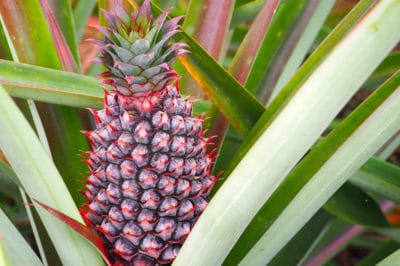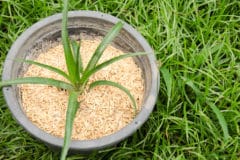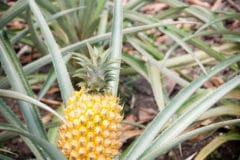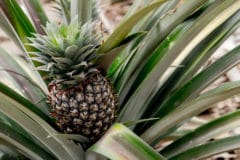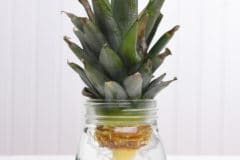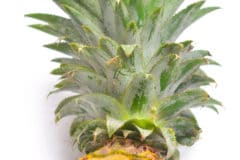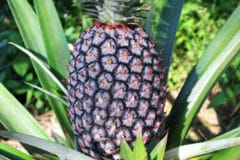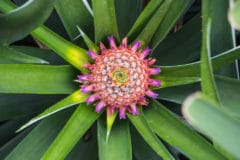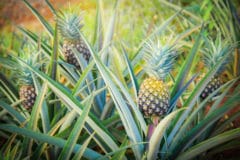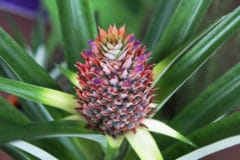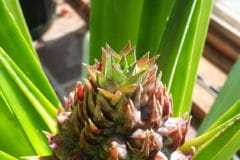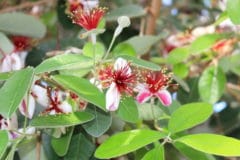Pineapple Botany
Christopher Columbus is credited with taking the first pineapple back to the old world from its native home in South America. The world’s most popular bromeliad, pineapples are considered herbaceous perennial plants. However, their growth habit is a bit more like a bi-annual.
Pineapples grow to heights of five to seven feet. Long sword-like leaves protrude from a central stem. Eventually, the stem produces hundreds of red and purple flowers. Some large varieties have more than 200 blooms. Each flower bears a segment of the pineapple fruit.
Nature’s pollinators of pineapple are hummingbirds. Commercial growers do not want seeds in the fruit so they avoid pollination. Selective breeding is done in controlled environments. Pineapple production in Hawaii one prohibited the presence of hummingbirds on the islands.
Perennial or not?
Gardening magazines across the globe will call pineapple plants herbaceous perennials. They will also claim that each plant produces just one fruit before dying. These statements seem to be at odds. Perennial plants live and produce for years. Annual plants die after one productive year.
Some gardeners claim to get multiple fruits from one pineapple plant. What is going on? It’s a bit of everything combined into one uniquely fruiting plant.
A pineapple plant produces its first fruit on a central stem. Technically, this is the only fruit belonging to this plant. After harvest, the roots of the plant will live on and produce new shoots. Each of the shoots can produce an additional pineapple.
The shoots are considered the propagational growth of the original plant, and not a part of the plant itself. Whether left in place or transplanted to a new location, the shoots will produce fruit. A plant will live for up to four years producing shoots.
How Long To Flower?
Days to maturity can drastically differ between varieties, climates, and growing conditions. Dozens of pineapple cultivars exist.
- Smooth Cayenne – World’s most popular pineapple. Originally from Venezuela, it’s low fiber, sweet flavor, juice, and absence of spines it gained popularity among growers.
- Hilo – A smooth cayenne variant grown in Hawaii. Small crown, large fruit
- St. Michael – a large 4-5lb fruit with such sweetness it isn’t preferred when ripe.
- Giant Kew – Grown in India, known for producing a 22lb fruit. Fruits average 6-10lbs. The core is too large to produce canned slices.
- Monte Lirio – Grown in Mexico and Central America, this is a white-fleshed pineapple. Popular European export.
It also depends on how the plant started. A slip is an offshoot of the original plant. A top is the top of a pineapple fruit. Both can be used to propagate pineapples. Plants started from tops take several weeks to a month longer to become established then plants started from slips.
From planting, pineapples will take approximately 10-15 months to flower. Plant from seed will take an additional 15-18 months to becomes established and transplanted into the field. This is largely why pineapples are mostly propagated vegetatively.
How Long To Fruit?
The general rule for pineapples is 24 months from propagation to fruiting. Once the fruit reaches full size, it takes three to five weeks for it to ripen. Pineapples can be picked before they’re ripe but they won’t be better for it. They will sweeten on the counter but not develop good flavor. Pick a pineapple when it is 1/3 or more yellow.
A pineapple is ripe when the spines flatten out, and the fruit turns from green to yellow or bronze. This process begins at the bottom of the fruit and works upward.
Propagation
The best propagative materials on a pineapple plant are medium-sized slips. These will establish and produce the fastest. Once commercial growers valued cultivars that produced abundant slips for propagation. Today, they realize that plants which put energy into lots of slips produce smaller fruit. Plants with fewer slips are now preferred commercially.
